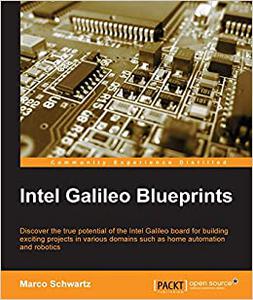
Marco Schwartz, "Intel Galileo Blueprints"
English | 2015 | pages: 192 | ISBN: 1785281429 | PDF | 4,8 mb
Discover the true potential of the Intel Galileo board for building exciting projects in various domains such as home automation and robotics
About This Book
- Use the power of the Intel Galileo boards to build exciting 'do-it-yourself' projects
- Build inter-connected IoT projects using the Intel Galileo and several ready-to-use web APIs
- Use the advanced features of the Galileo board to control your projects in real-time from anywhere in the world
Who This Book Is For
If you are an experienced developer using classic Arduino boards and would like to extend your knowledge to the Intel Galileo board and polish your project building skills, this book is for you.
What You Will Learn
- Monitor data remotely using the onboard Ethernet connection
- Control outputs using the Galileo board and control the board remotely
- Store and Description monitored data in the cloud
- Access your Intel Galileo projects from anywhere in the world
- Automate your garden and monitor it from the cloud
- Create a whole home automation system using the Galileo board as the hub
- Build a mobile robot based on your Galileo board
In Detail
The Intel Galileo board was designed to add the power of an Intel processor to the simplicity of the Arduino platform. Intel Galileo gives you the freedom to create a wide range of DIY projects. Intel Galileo Blueprints will be a detailed guide that covers several projects based on the Intel Galileo board, exploiting the full potential of the board.
You will first go through how to set up the development environment for the Galileo board. Next, you will connect different kinds of sensors to the Galileo board, and learn how to use the SD card reader of the board. You will then connect actuators to the Galileo board, like a relay and a servomotor, and write simple software to control these components. Later, you will access the Galileo board remotely in order to monitor the measurements done by the board and send the measured data to a Twitter feed at regular intervals. Finally, you will move on to more advanced topics, such as building a complete home automation system, building a mobile robot controlled by the Intel Galileo board and computer vision applications such as face recognition.
Links are Interchangeable - No Password - Single Extraction



